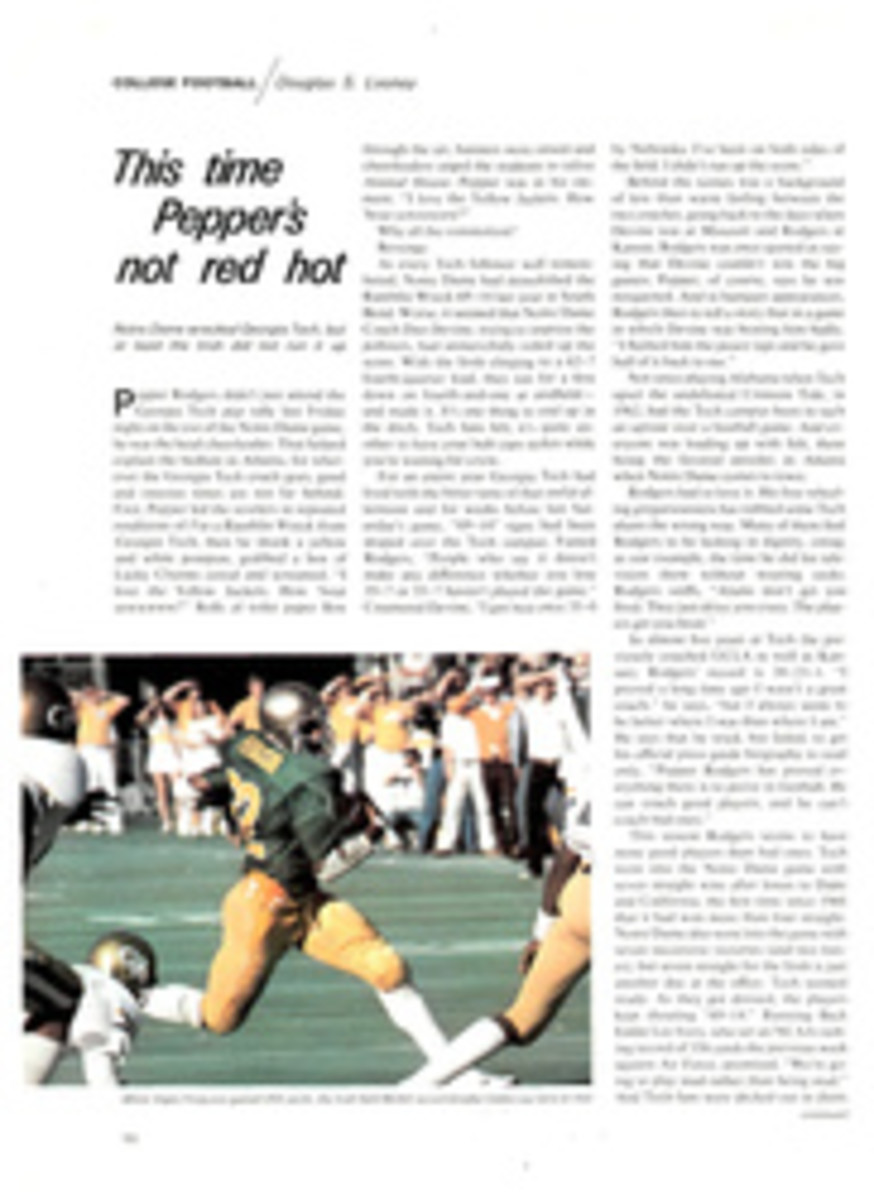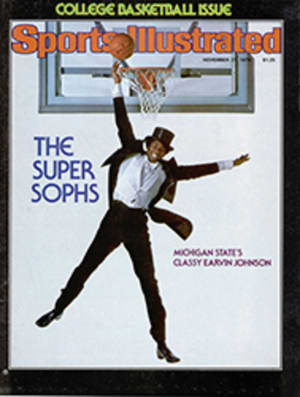
COLLEGE BASKETBALL
Most years college basketball changes just enough to stay the same. Players come and go, a mini-trend or two develops, and UCLA wins the NCAA championship. Except that it has now been three years since UCLA won the title and two years since the Bruins made the final four. It's high time people realized that UCLA isn't UCLA anymore. Now that's a harbinger of a major trend.
Granted, UCLA is ranked third in this year's SPORTS ILLUSTRATED Top 20, but its mystique is gone, and at this time next year the Bruins are likely to be gone from the rankings, too. If that happens, it will be final confirmation that a significant power shift has taken place. There is already considerable evidence that sweeping changes are under way, because many of the traditional powers that, along with UCLA, have dominated the polls for years are not ranked.
One of the new have-nots is defending NCAA champion Kentucky, four of whose top seven players were swept up in the pro draft. Other notable MIAs include: Marquette, North Carolina, Cincinnati. Nevada-Las Vegas, Alabama, Maryland. Purdue, Kansas State and Providence. In fact, in this year's SI Top 20, only Notre Dame, UCLA, Louisville, San Francisco and Syracuse are holdovers from last season.
Why didn't all those perennial powers have talent waiting in the wings as they seemed to in the past? Mainly because today's best high school seniors know that they are accomplished enough to start immediately on a good or soon-to-be-good team, such as an Iona or an LSU or a Mississippi State. Thus, they are less inclined to serve a year's apprenticeship at a Marquette or a North Carolina before getting a chance to show what they can do. This is even the case in Los Angeles, where UCLA always had a Keith Wilkes to replace a Sidney Wicks, but where the Bruins have now been outrecruited two years in a row by their resurgent neighbor, USC.
The NCAA rule restricting team scholarships to 15—there were no limits until 1975—also helps prevent the kind of stockpiling for which Kentucky was notorious during its heyday in the 1950s. Another compelling reason for the power shift is the relative decline of UCLA, which under John Wooden won 10 NCAA titles in 12 years. Wooden's adversaries were in awe of him and his teams. Despite paying lip service to the business about the Bruins putting their shorts on one leg at a time, very few coaches believed they had any chance of beating UCLA. Now the psychological barriers are down. These days every school, from a pipsqueak like Iona to a monster like Michigan State, figures it has a chance at the national title.
The only league that put up much of a fight during UCLA's reign was the Atlantic Coast Conference, whose 1974 champion, N.C. State, upset the Bruins on the way to winning the NCAA title. North Carolina and Duke also made it to the final four a total of five times during Wooden's championship years, and both have gotten there in the post-Wooden era, Carolina in '77 and Duke last year.
The surprising Blue Devils caught fire late last season under Coach Bill Foster, who put them back together after a recent history of failure and molded them into a team that has become this year's runaway choice for No. 1. In concept and technique, Foster's program has not been unlike the building and rebuilding efforts now coming to fruition at a lot of former have-nots. There's only one real difference—he has succeeded better than anyone else.
Duke finished in the wire services' Top 20 eight times during the 1960s as Coach Vic Bubas trotted out one All-America after another. But in 1969, Bubas, then 42, resigned to become a Duke vice-president, and his assistant, Bucky Waters, replaced him. Waters' strength was recruiting. Period. He didn't get along well with his players, and in the space of two years seven potential starters transferred to other schools. In September 1973 Waters resigned, and when fall practice began on Oct. 15, the athletic department still hadn't found a replacement.
Then in a move born out of panic, a press conference was scheduled for the morning of Oct. 18 in which—believe it or not—Adolph Rupp was to be introduced as the Blue Devils' new coach. Then 72 and 18 months removed from his longtime coaching job at Kentucky, Rupp was plagued by a variety of ailments. Moreover, Duke Chancellor Ken Pye and others were concerned about the effect Rupp's antebellum views on race would have on the Duke campus, which had been integrated only since the mid-1960s. Fortunately for all concerned, Rupp backed out at the last minute.
Instead of a legend, Duke settled for an interim coach, Waters' assistant Neil McGeachy, who did well to finish 10-16. Meanwhile, the search committee that ultimately hired Foster was seeking out several other prominent coaches. Their replies were harsh and to the point: "Duke doesn't have the kind of situation where a coach can be successful.... Your academic standards are ridiculous.... You require a coach to work with both hands tied behind his back."
"The unfortunate part was that I believed them," says Pye, "at least in terms of the odds being against our rekindling what Bubas once had going. Our average freshman has a College Board score of 1,200, although we have always made exceptions for special people who fall into the category of, say, poets, violinists or athletes."
This news must have been music to Foster's ears when he was interviewed for the Duke job in March '74. And Foster, an Elizabethtown (Pa.) College alumnus who had resurrected basketball programs at Rutgers and Utah, impressed the now more realistic search committee with some sound talk of his own.
Most coaches are workaholics, but few combine this trait with a master's in business education, as Foster does. A genius at organizing a staff and allocating time, Foster had no sooner taken the Duke job than he began speaking three times a day all over North Carolina. He huddled with the promotion-conscious Dallas Cowboys and conceived the idea of toting mobile baskets and his players to high school assemblies so that students could come up on stage and "Shoot It Out With The Blue Devils!" Foster also instituted something called Management by Objectives, a system borrowed from the head of the Utah business school wherein a player's weekly performance in everything from grades to free-throw shooting to brushing his teeth is monitored. As word of Foster's approach to basketball spread, he began getting requests to speak before IBM executives on how to get more out of less, a situation he was still having to deal with on the basketball floor.
What is often forgotten in the wake of Duke's magnificent run to the NCAA finals last season is that the Blue Devils came from nowhere. Foster began 1977-78 with a three-year record of 40-40. His ACC record was a horrid 7-29. "When I came to Duke, Jack Marin and Jeff Mullins were ending their pro careers, and our other names didn't exactly move mountains," says Foster. "But I've always remembered what Pat Williams, the 76er general manager, once said, 'When you don't promote, a terrible thing happens. Nothing.' So I tried everything I could think of to start people talking about Duke basketball again."
Among Foster's other pressing problems were getting antiquated Cameron Indoor Stadium spruced up from floor to ceiling and finding a shiny new team to play there. All Cameron needed was paint everywhere, a brand-new floor and some bleachers to replace those that caved in one night in 1976 while Duke was upsetting Maryland.
Foster's energetic recruiting—he was on the road 200 days last year—and ability to discern talent laid the groundwork for last year's 27-7 season. Unable to attract a surefire star, he beat the bushes during his first year at Duke until he had come up with the best unheralded guard prospect in the country, Jersey City's Jim Spanarkel, whom Foster judged to be like one of the Van Arsdale twins. Foster was wrong; Spanarkel, as it turns out, is more like both Van Arsdales playing at once.
Shut out on several hotshots and unwilling to take a chance on players who might not fit into his grand design, Foster gave out only one scholarship the next year. It went to 6'11" Mike Gminski, a Connecticut lad of 16 who was smart enough to go through high school in three years and then conduct his own private recruiting campaign while most coaches were waiting to see how he would do in his senior year. Gminski spent it in the ACC, winning Rookie of the Year honors as Spanarkel had the season before.
Getting last year's freshman star Gene Banks, the most impressive forward to hit the college game since Wicks and the first highly sought recruit signed by Foster, gave Duke a potential NCAA champ built along classic NBA lines: an intimidating center, a power forward and a whirling dervish (Kenny Dennard) across the front line, and a big shooter (Spanarkel) who does everything and a choice of two sound point men (John Harrell and Bob Bender) in the backcourt. What's more, Foster has never given out all his grants-in-aid. At the moment he has only 12 players on scholarship, and next season, when five members of this year's team will have graduated, there will probably be just 10.
"I know a lot of coaches think I'm crazy shaving the odds this close," says Foster, "but we have players on our bench who are good enough to come in and do the job if we have injuries or sickness. I just don't believe in keeping a lot of potential starters bottled up there who don't play much. It's bad for morale and distracts you from your purpose, which is winning."
Duke is about to do a lot of that, to the delight—and frustration—of its fans. Over the summer Duke received 23,000 new requests for the 4,307 tickets available to non-students.-And then there is the matter of what to do about the 74 donors of $25,000 to the university and the 39 donors of $100,000 who still can't-get in the door to see a game.
"It's hard to believe," says Foster, "particularly since I remember going up into the balcony one day and posing for a poster whose headline read: THERE'S AN EMPTY SEAT WAITING FOR YOU AT CAMERON INDOOR STADIUM."
Obviously, Foster is happy to be at Duke. And he can prove that his presence there is no accident by pulling out a dog-eared clipping from a Wilmington, Del. newspaper that he has carried in his wallet for 29 years. It reads: "Bill Foster, 18-year-old basketball whiz, is university bound, and the word is that it is Duke."
Foster took quite a while to arrive, but now that he is there, all around the country the word is that it is Duke.
For the word—and pictures—on this year's sophisticated sophomores, including Duke's Banks, turn the page. And keep reading for analyses of the Top 20 by Kent Hannon, Roger Jackson, Joe Jares, Larry Keith, Bruce Newman and William F. Reed, plus a look at the best of the rest among major college teams, the lowdown on the toughest small schools and the Top Ten in women's competition.
TWO ILLUSTRATIONS

